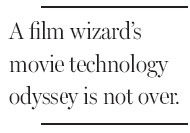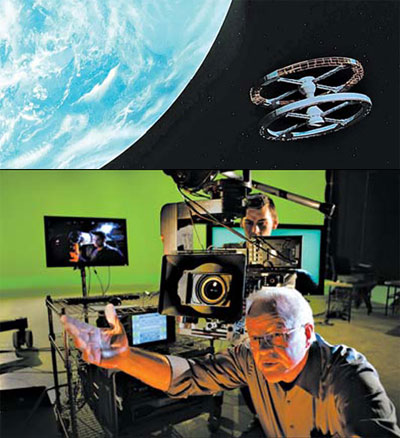Still creating those otherworldly effects
Updated: 2012-02-12 07:52
By John Anderson(The New York Times)
|
|||||||||
|
Douglas Trumbull earned a special Oscar for his work on movies like "2001: A Space Odyssey," top, and "The Tree of Life." MGM / Warner Brothers Pictures; above, Joseph Heck |
The special Oscar given this year to Douglas Trumbull, for his technological contributions to film, could be seen as a valedictory tribute, the cap on a career that began with Stanley Kubrick and "2001: A Space Odyssey" and includes a best-picture nominee this year, "The Tree of Life."
But Mr. Trumbull, 69, is hardly finished with his contributions. At his home and studio in the Berkshire region of Massachusetts, about 320 kilometers from New York City, mad experiments in cinema are taking place. Mr. Trumbull is working on new production paradigms.
"Kubrick was pushing into this new, nonverbal territory that took the audience on an adventure in space," Mr. Trumbull said, recalling his debut, as a visual effects supervisor on "2001." "It wasn't about the normal cinematic dynamics of close-ups and over-the-shoulder shots and reversals and conflicts and plot. He was trying to go into another world of first-person experience. I said, 'Sign me up.'"
But this brave new world was soon eclipsed by Hollywood's embrace of the blockbuster, and the results, he said, are damaging the industry. "If you spend 150 to 200 million on a movie and take all of that value and try to cram it through this narrow slot," he said, referring to the standard movie-house experience of small and underlighted screens, "you're throwing away most of the production value."
With a few simple changes, he said, "you could massively amp up the effect of these kinds of movies" - like the ones he's known for, "Blade Runner," "Close Encounters of the Third Kind," "Star Trek: The Motion Picture." Make them brighter and bigger and run them at higher frame rates; that is, the speed at which individual pictures, or frames, are flashed in front of the audience.
Since the silent era the industry standard has been 24 frames a second. Peter Jackson is shooting "The Hobbit" at 48; James Cameron may well make "Avatar 2" at 60. Mr. Trumbull is talking 120.
Because of what is known as "persistence of vision," the human eye is fooled into interpreting the rapid projection of individual images as motion. But though viewers may not realize it, at 24 frames per second, the eye is being presented with darkness more than half the time. The faster the frame rate, the more lifelike the image.

"There are really no words for it in English," he said of his development, "but it's a window onto reality."
In the '70s Mr. Trumbull started the Future General Corporation to develop new film technologies, including Showscan, an Imax-like format that used 70-millimeter film projected at 60 frames a second. The film critic Joe Morgenstern saw a Showscan demonstration in the late '70s and said: "I remember the smoothness and richness of it, almost a three-dimensionality. "
Paramount hired Mr. Trumbull to make the first feature in Showscan, "Brainstorm," a film known less for its technical achievements than for the death of Natalie Wood, the event that led to Mr. Trumbull's departure from his native Los Angeles.
But the film wound up caught between traps. "The theaters said, 'We love it, but we're not going to put in projectors unless all the studios shoot that way,'" Mr. Trumbull recalled. "And the studios said, 'We're not going to make movies like this unless the theaters put the equipment in.'"
Though his firms Ridefilm Theater and the Trumbull Company would later merge with Imax, Mr. Trumbull asserted that in comparison with Imax's big-screen 3-D presentation, "my new Hypercinema 3-D 120-frames-per-second technology is far superior and much less expensive."
What will be projected, he said, can be made at his studio cheaper and faster than in the Hollywood system because he has developed technology that reduces the need for sets, locations or a large crew.
He contends that for Hollywood, it's about self-preservation. "So if you want to get people to go out to the movies, to pay a premium price for some kind of premium experience, it better be damned premium. It better be extraordinary."
The New York Times
(China Daily 02/12/2012 page11)
